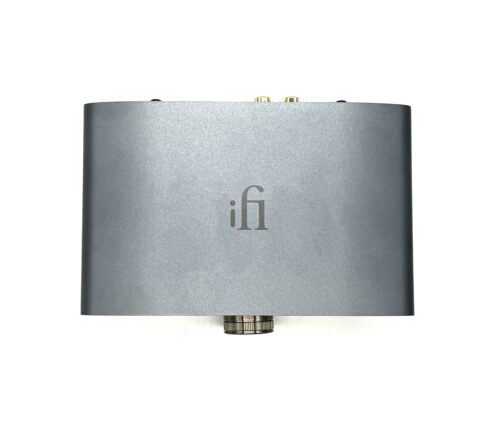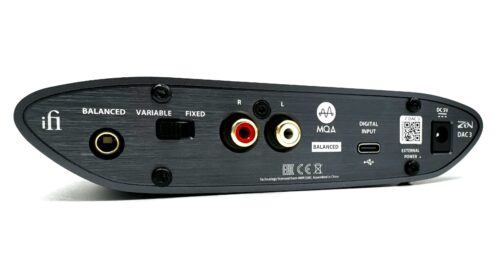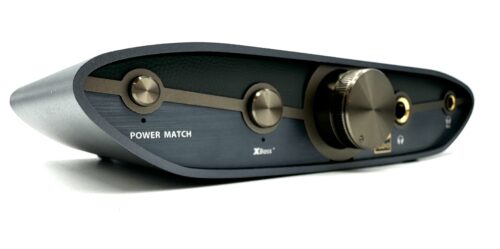iFi’s Zen DAC series is well known in audiophile circles as one of the best budget all-in-one’s you can get for the price. As an entry-level to mid-fi device, the first two generation Zen DACs have offered great value. But as always, iFi looks to improve all of their products, with consistent iteration across all of their product lines. Now they aim to improve the Zen DAC line once again with the Zen DAC 3. With the new model, iFi has updated the device both internally and externally, and raised the price to $229, leaving us with quite a bit of ground to cover. So let’s just get right into it.
What’s in the Box:
- Zen DAC 3
- RCA Cable
- 3.5 to 6.3 mm Adapter
- Quick Start Guide
- Instruction Card

Build:
Above the hood, iFi mixes up what has become a classic look for the brand. Yes, the rounded, askew shape remains intact, so you can mix and stack it with previous generations of iFi products. But without looking for too long, you’ll notice the facelift the Zen DAC 3 has received. On the front panel, you now get a dual material faceplate with a separating accent line in between. The look is modern and elegant, a welcome change to the all-brushed aluminum look of the first two generation Zen DACs.
On this face plate are a balanced 4.4mm headphone output as well as a 6.3mm one for single ended use. To the left of those are the volume dial, which has a glowing ring around it to indicate the type of file being played. Then there are two buttons: one for XBass control and the other for activating “Power Match” (XBass, of course, handles bass adjustment, and Power Match controls the gain levels of the amplifier).
On the back, you get a balanced 4.4mm output as well as a single ended RCA output. Then there’s simply a USB-C input (an update to the old USB type-B input of the older generations) and a switch to control variable or fixed mode (variable is for controlling headphone and preamplifier volume, fixed is for bypassing analog volume control entirely). And finally, there’s a DC power input if you want to power the device externally. Of course, iFi is also known for their power supplies and they encourage you to try those out with this device for best performance.
The general build of this device is really good. It takes an already great design formula and improves it just that much more. I/O is okay – for the price point, it might have been nice to get another option or two for inputs. Otherwise, there’s not much to complain about here.

Design:
If the physical changes to the Zen DAC weren’t enough for you, iFi also updated some of its design features as well. Sticking with Burr-Brown, the Zen DAC 3 now uses a 16-core XMOS processor, which should enhance playback capabilities quite a bit. The device now supports files up to 768 kHZ PCM, DSD 512, and MQA. The Burr-Brown chip is True Native, which means you’re getting your files in bit perfect form. So you’ll be able to hear the music as the level of quality that the artists created them in.
Power-wise, you’ll get 210mW at 32 ohms single ended, and 390mW at 32 ohms balanced. It may not seem like a lot, but I was able to adequately power Sennheiser’s HD660S2, and both Meze’s 109 Pro and Liric II using the power match function when needed. That said, if your main headphones are power hungry, you may want to opt for an external amp to go with this DAC. Of course, iFi makes amplifiers in the Zen line that stack with the Zen DAC 3.
Sound Impressions:
As mentioned, I tried the Zen DAC 3 with the Sennheiser HD660S2 and Meze’s 109 Pro and Liric II. This selection of headphones gave me an idea of how the Zen DAC could reproduce sound, as well as power headphones in multiple power and price brackets. Up top, I found the Zen DAC 3 to be pleasant and engaging. It does lean just the littlest bit warm, smoothing out treble and giving vocals a nice musicality.
Listening first with the 109 Pro, I found the Zen DAC 3 to be fast and accurate. For example, on the live track “Big Love” by Fleetwood Mac, I got a good sense of attack and decay. As I mentioned the treble is a bit smoothed out, which is a good thing with the 109 Pro, which can be a tad bright at times. Bass was nice and balanced and I never found myself needing XBass with them. But we’ll cover XBass in full at the end of this section. Soundstage and imaging is solid. It isn’t the widest or deepest I’ve ever heard, but it makes up for that by sounding quite natural. Sometimes with more affordable DAC/Amps, the soundstage feels artificially wide, but that is not the case here.
Moving onto the HD660S2, I got a better chance to try out XBass and Power Match. In fact, I found Power Match to be necessary for all listening with these. If you own hard to drive headphones like these, you’ll definitely want to run it balanced and with power match activated. With that set up, I found the HD660S2 to be nice and neutral, if a little intimate, but that’s just the character of these headphones. With XBass turned on, the low end was deep and punchy without any coloration of the mid range. Mids were beautiful as you’d expect, and once again, the treble was nice and smooth.
Finally, I ran the Liric II out of this device to see how it could scale, and to be totally honest, it scaled quite well. With the Liric II, I got a better sense of space with a wider soundstage. Again, everything just felt smooth. I found that it was able to do everything from classic rock, to hip/hop, to modern pop very well. That said, it did expose the limitations of an entry-level DAC/Amp like this. You still don’t get a sense of open space or a great range of micro-detail. But that’s not what this device is meant for, and the fact that it could scale at all, let alone as well as it did, is a great sign for the Zen DAC 3.
Now, just a quick word on XBass. As has been said before, the beauty of XBass is that it adds to the texture and quantity of bass without impacting the rest of the frequency response. That said, I found it to be useful on a case by case basis. Unless you’re a true bass head, not every track will call for XBass. But when it does, you’ll be happy you have the feature available. It can really add life and energy to a track that has less bass on it.
Final Thoughts:
The Zen DAC 3 is a really nice upgrade to the Zen DAC lineup. As a DAC, it does a solid job reproducing music and is compatible with the latest audio formats. As an amp, it has plenty of power, though a separate dedicated amplifier can definitely take things to the next level. If you’re an entry-level to mid-fi audiophile, the Zen DAC 3 is definitely worth a look.
The iFi Zen DAC 3 is available at Audio 46.
Compare the ranking of various headphones, earbuds and in-ear monitors using our tools.
Discuss this, and much more, over on our forum.
---MAJORHIFI may receive commissions from retail offers.
















